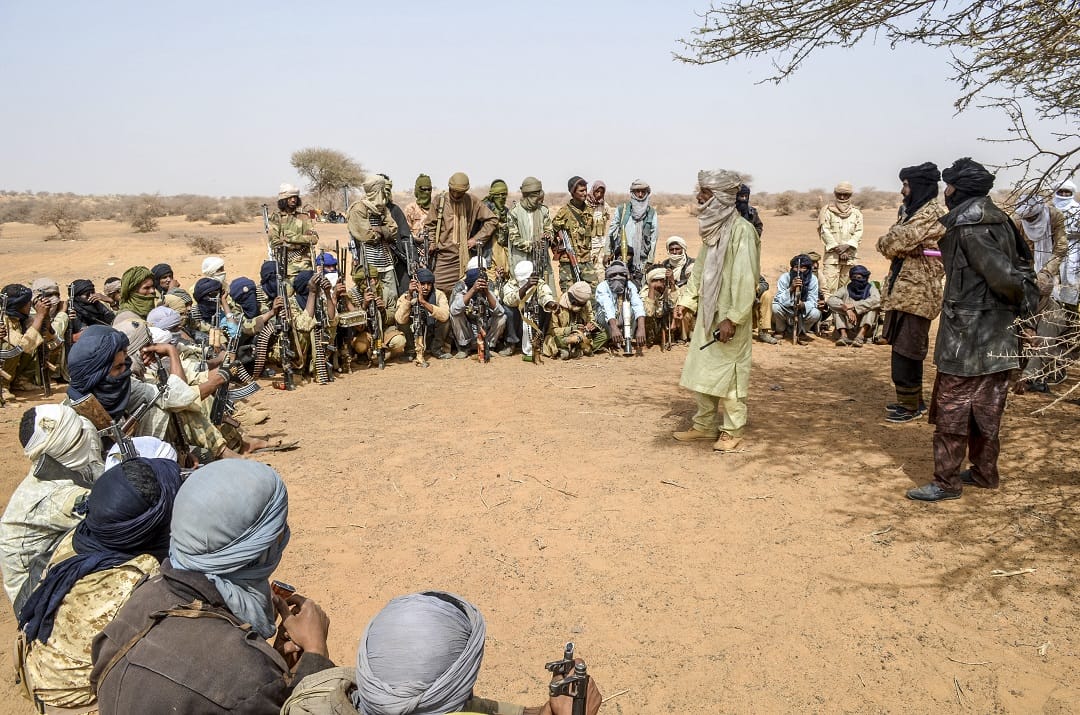
by Fabio Seferi
The territorial retreat of the so-called Islamic State in the Middle East has caused a de facto geopolitical re-articulation inside the perimeter of the jihadist movement. Whereas the self-proclaimed Caliphate is not viable anymore in Syria and Iraq, other regions of the world have gained attention as to what pertains Islamist violent extremism: the most important ones being South-East Asia and the Western Sahel (which, for the purpose of this article, encompasses Mauritania, Mali, Burkina Faso, Niger, Chad, Southern Algeria and Northern Nigeria). Given its geographic proximity to the European continent, the latter poses higher risks and threats to transatlantic security. The region indeed is a crossroads for many phenomena that spill over to Europe’s southern flank: mass migration, trafficking of humans, drugs, and arms. These in turn are the region’s economic veins along which the separation between violent extremists and organized crime groups is blurred at best. Hence, international state actors (predominantly European governments) are becoming increasingly concerned over the developments of the region, while trying to foster military training missions and economic development policies in order to restore stability.
A snapshot of Western Sahel
The countries of the Western Sahel all face similar challenges: low levels of human development, permeable borders, chronic corruption, lack of government authority and police enforcement in peripheral areas as well as intra-state divisions along ethnic/tribal/clan lines. These features lead to overall political uncertainty and to a power vacuum which creates a perfect environment for collective extremist postures to emerge. The state is delegitimized because central authority and the administration are seen as corrupt. Internal fights for economic resources leave the dispossessed (that usually belong to the most fragile and weak segments of the population) with no other viable alternative than joining extremist groups for their own survival. Consequently, these cleavages and social emotions (mainly grievances and fear) can be channelled and exploited by jihadist organizations, which recruit local people by providing a parallel security architecture. State abuse drives this home-grown type of jihadists. Thus, Islamic ideology is not embraced for its inherent value-system but is used as a tool for ostensible individual emancipation and for organizing a violent environment. Interestingly enough, even though they have never been a victorious model, Islamist insurgencies have been on the rise in the last decades.
Ungoverned spaces therefore have led to the rise of violent extremist groups. The two basic largest jihadist organizations in the region include al-Qaeda in the Islamic Maghreb (AQIM), born from the ashes of the Algerian civil war, and Boko Haram, a group first established in 2002 in Northern Nigeria. The two groups align differently inside the global jihad: AQIM is a branch of the global al-Qaeda network, while Boko Haram has pledged allegiance to the so-called Islamic State. This results in different viewpoints on the priorities of the respective agendas and on the means to accomplish them. Foremost the role of terrorist attacks and the establishment of a state-like territorial organization. While al-Qaeda relied heavily on terrorist attacks, with the creation of an Islamic state postponed to the future, the so-called Islamic State predominantly formed larger armed units and immediately tried to establish itself as a government-like authority within a defined territorial space. Strategy and timing of establishing the self-proclaimed Caliphate is thus different for the two organizations. The distinction among groups in the Western Sahel is more difficult.
In the last decades, these latter groups have experienced different fragmentations, internal re-positioning and re-alliance, with some members forming new formations and giving birth to a plethora of groups and actors. Sometimes religious extremists overlap with other types of actors: smugglers, dealers, criminal gangs, paramilitary forces etc. Thus, these stances do not seem to be based (only) on ideological grounds: affiliations are merely consequences of internal frictions, ground tactics, and convenience. Moreover, all groups seek territorial control since that fuels their existence. Providing a parallel security apparatus and, as is often the case, restoring basic services, police, and judicial enforcement in peripheral areas, legitimates their actions towards the population. Therefore, it would be a useful conceptual framework to consider these groups as insurgents, who happen to have adopted jihadist ideology.
Threats to European security
The Sahelian powder keg does not provide major security concerns for the European continent and the Transatlantic Alliance in the short-run. The concerted action of France and the G5 Sahel (Mauritania, Mali, Burkina Faso, Niger, and Chad) have caused the retreat of AQIM and Boko Haram from much of the territories previously under their control. Moreover, their international projection is quite limited compared to that of al-Qaeda and of the so-called Islamic State. Drawing more from local support than from a transnational network of affiliates, Sahelian extremists focus predominantly on the developments of the region. However, if they would establish and strengthen themselves enough, they could expand terrorist attacks beyond their region in order to seek international recognition and allure foreign fighters to reach Sahelian battlegrounds.
A very important and delicate issue is the (possible) need to sign agreements with some of these shady groups. In Libya, for example, Western countries (especially Italy) have reached agreements with tribes and local actors in order to curb mass migration towards Europe. However, this enforces their authority over the population and, in a certain sense, legitimizes their rule and existence. There is thus a reason to avoid these types of agreements with the Sahelian groups. Many critical dimensions further complicate the picture: a booming population, widespread famine, violence, low levels of human development, and the worsened conditions of the Lake Chad (which provides for much of the water supplies in the region). This interplay can push people to either join extremist groups or to travel across the Trans-Saharan route up to Libya and then seek shelter in Europe. The worsening of these conditions would only exacerbate the bottleneck effect in North Africa, further destabilising the region, European politics, and public opinion.
What possible role for NATO?
NATO’s role in such an environment should be meticulously calibrated. After the 2011 Libyan intervention, the collapse of the Qaddafi regime and the opening of the Pandora’s Box of the region, a NATO direct intervention would not gather much support among the African partners. So far, action lies more upon single member states: this is the case of France which, for example, backs up the G5 Sahel security alliance, whose members are the countries most affected by extremist violence – Mauritania, Mali, Burkina Faso, Niger, and Chad. Moreover, France has deployed counterterrorism forces to these countries, while also seeking for more international support. Except for the European Union Training Mission Mali (EUTM), commitments of other European countries are rather moderate. The United States (U.S.), on the other hand, have developed a major military review that foresees the cut of command forces in Africa. With strategic priorities shifting towards other global superpowers and scenarios (namely, China, Iran, and North Korea), the U.S. administration probably will adopt narrower and more specific counterterrorist efforts in the Sahel. That is, it will try to find a balance between counterterrorism in unstable areas and rising security challenges worldwide. However, the high volatility of the region does not allow for a full disengagement. The United States should therefore still be present in the Sahel, even if with reduced forces.
NATO could provide the perfect framework for concerted action by the Transatlantic Allies. Since rooting and strengthening of jihadi organizations take shape in areas where state authority is weak, the first steps towards their eradication should be ensuring basic safety within the Sahelian region through efforts of local state actors, not by direct military action of the Alliance, which would worsen NATO’s perception with the African partners. Counterinsurgency measures (such as selective violence, for example) also seem counterproductive. In areas where the state abuses and marginalizes people, repercussions and violence against civilians could further boost their loyalty for Islamist insurgents. Security Sector Reform as well as training missions for armies and police forces of the countries concerned should therefore be at the forefront of this strategy. A common approach of the G5 countries could result in stronger state control of the border zones in which jihadist groups proliferate. Only after having achieved the control of the region and the security of the people under the extremists’ rule, there can be an opportunity for more pervasive economic and judicial reforms. Indeed, providing basic safety alone would not be enough, since this would not solve the deepest problems of the region mentioned above: state corruption and abuse, intra-state divisions along ethnic lines which bring frictions among different ethnic groups, and a lack of legal economic opportunities. Thus, a strategy for the Sahel in fact requires the common involvement of the tools and means of both NATO and of the European Union with its development cooperation capabilities. With security encompassing broader issues than just public safety, there should be efforts to strengthen overall inclusiveness of the most fragile segments of the population, while fostering democratic participation, rule of law and social emancipation. The challenges are manifold in the Sahelian region, but still there is time to take action in a comprehensive way before the situation becomes more unstable with repercussions not only for the region but also for European NATO Allies.
*The author would like to thank Timm Schulze for useful comments on previous drafts of this article.
Bibliography
Abdelhak Bassou, “Violent Extremism in the Sahel: The Birth of a Third Generation of Terrorism?”, OCP Policy Center, Policy Brief – April 2018.
Rasmus Alenius Boserup and Luis Martinez, “Countering jihadist mobilization: EU has a stake in the struggle against jihadism in the Sahel”, Danish Institute for International Studies, 23 November 2017, https://www.diis.dk/en/research/countering-jihadist-mobilization-eu-has-a-stake-in-the-struggle-against-jihadism-in-the
Anouar Boukhars, “The Paradox of Modern Jihadi Insurgencies: The Case of the Sahel and Maghreb”, Al Jazeera Centre for Studies, 15 July 2018, http://studies.aljazeera.net/en/reports/2018/07/paradox-modern-jihadi-insurgencies-case-sahel-maghreb-180715094436599.html
John Campbell, “The Islamic State ‘Presence’ in the Sahel Is More Complicated Than Affiliates Suggest”, Council on Foreign Relations, 01 June 2018, https://www.cfr.org/blog/islamic-state-presence-sahel-more-complicated-affiliates-suggest
Jennifer G. Cooke and Thomas M. Sanderson, “Militancy and the Arc of Instability: Violent Extremism in the Sahel”, Center for Strategic & International Studies, Report – September 2016.
Dalia Ghanem-Yazbeck, “Jihadism In The Sahel: Aqim’s Strategic Maneuvers for Long-Term Regional Dominance”, Carnegie Middle East Center, 23 June 2017, https://carnegie-mec.org/2017/06/23/jihadism-in-sahel-aqim-s-strategic-maneuvers-for-long-term-regional-dominance-pub-71413
Thomas Gibbons-Neff and Eric Schmitt, “Pentagon May Cut Commando Forces in Africa in Major Military Review”, The New York Times, 04 June 2018, https://www.nytimes.com/2018/06/04/world/africa/commandos-africa-pivot-major-powers.html
Luca Raineri and Francesco Strazzari, “Jihadism in Mali and the Sahel: Evolving dynamics and patterns”, European Union Institute for Security Studies, Brief Issue – June 2017.
Benita van Eyssen, “Attack on Sahel counterterror force puts jihadists in focus”, Deutsche Welle, 03 July 2018, https://www.dw.com/en/attack-on-sahel-counterterror-force-puts-jihadists-in-focus/a-44494457
